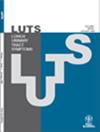Freeflow: The novel portable uroflowmeter can help to realize practical urinary conditions at home
Abstract
Objectives
To evaluate the effectiveness of a novel portable urine flowmeter, Freeflow, for examining the actual state of urination at home.
Methods
Forty-three patients with benign prostatic hyperplasia used the Freeflow uroflowmeter in the hospital and at home without accumulating urine. We created a nomogram for each patient's urine volume and maximal urinary flow rate (Qmax). Furthermore, we investigated the actual state of each patient's urination. We also investigated the differences in the micturition status between daytime and nighttime.
Results
Of the 43 patients, 40 were able to provide the necessary data in the hospital, and all patients provided data measured at home. The trial period of the home assessment was 2-7 days. Regarding the average urine volume, no significant difference was observed between in-hospital and at-home patients; however, Qmax and mean flow rate (Qave) were significantly higher at home. The average coefficient of variation was very large. The relationship between daytime and nighttime was observed in 30 patients; urine volume increased significantly at nighttime; however, no significant difference was observed in Qmax and Qave. The nomogram for several days and a completed urinary diary helped to display daytime and nighttime urination characteristics.
Conclusions
Freeflow, the newly developed uroflowmeter, enabled us to determine the fluctuations in the measurements recorded at home and the differences between daytime and nighttime. Thus, creating a nomogram for objectively examining nighttime urination status and utilizing a urination diary was found to be effective for providing correct diagnosis and treatment of lower urinary tract symptoms.

 求助内容:
求助内容: 应助结果提醒方式:
应助结果提醒方式:


